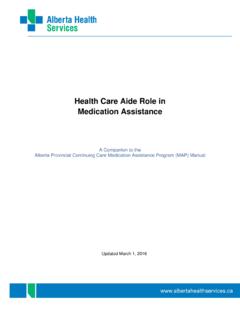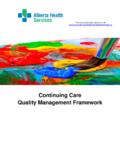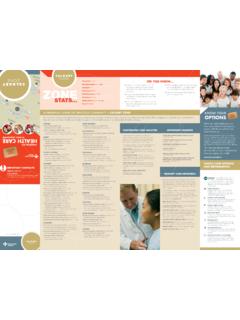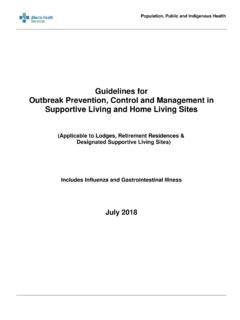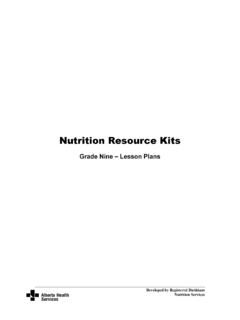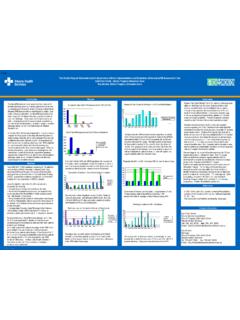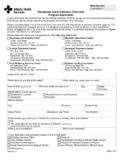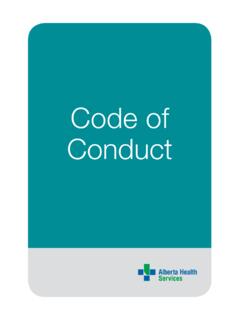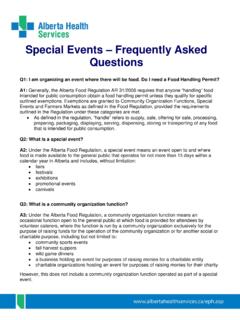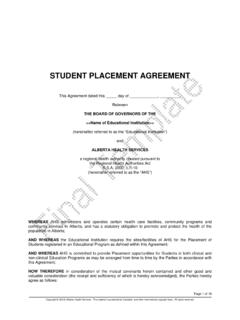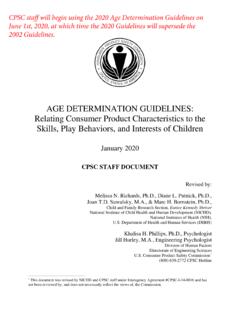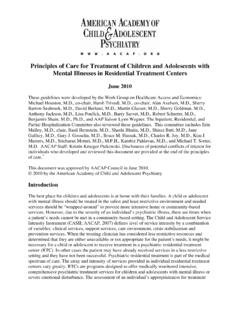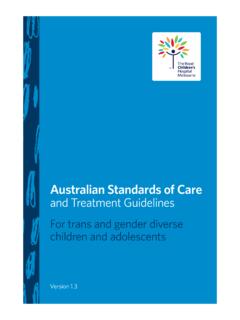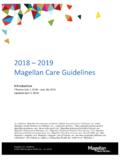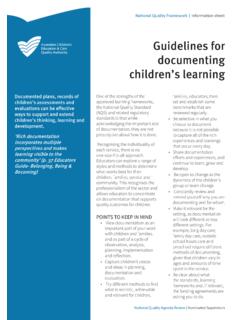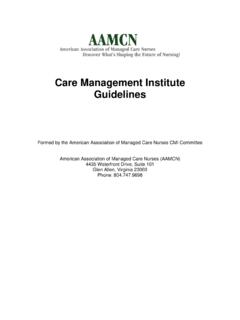Transcription of Health and Safety Guidelines for Child Care Facilities
1 Health and Safety Guidelines for Child care Facilities April 2017. Health and Safety Guidelines for Child care Facilities 2018 Alberta Health Services Safe Healthy Environments This copyright work is licensed under the Creative Commons Attribution- Noncommercial-NoDerivative International. You are free to copy and distribute the work including in other media and formats for non-commercial purposes, as long as you attribute the work to Alberta Health Services Safe Healthy Environments do not adapt the work and abide by the other license terms. To view a copy of this license, see: The license does not apply to content for which the Alberta Health Services Safe Healthy Environments is not the copyright owner. This material is intended for general information only and is provided on an "as is", "where is" basis. Although reasonable efforts were made to confirm the accuracy of the information, Alberta Health Services Safe Healthy Environments does not make any representation or warranty, express, implied or statutory, as to the accuracy, reliability, completeness, applicability or fitness for a particular purpose of such information.
2 This material is not a substitute for the advice of a qualified Health professional. Alberta Health Services Safe Healthy Environments expressly disclaims all liability for the use of these materials, and for any claims, actions, demands or suits arising from such use. PUB-0394-201807. Safe Healthy Environments Environmental Public Health 2. Health and Safety Guidelines for Child care Facilities Table of Contents Table of Contents .. 3. Introduction .. 5. Regulations .. 5. Roles & Responsibilities .. 6. Design & Approval .. 6. Plumbing and Sinks .. 6. Water 7. Sewage System .. 7. Washrooms .. 7. Shared Washrooms .. 8. Heating and Air 8. Windows and Doors .. 9. Stairways .. 9. 10. Storage Areas .. 10. Sick Child 10. Laundry Areas .. 10. Food Preparation Areas .. 11. Sleeping Areas .. 11. Operational Requirements .. 11. Food Handling .. 11. Diapering .. 12. Personal Hygiene .. 12. Safe Healthy Environments Environmental Public Health 3. Health and Safety Guidelines for Child care Facilities Communicable Diseases.
3 13. Outbreak 14. Sleeping .. 15. Play Equipment .. 16. Swimming Pools & Wading Pools .. 17. First Aid Kit .. 17. Equipment and Safety .. 18. Maintenance and Cleaning .. 18. Laundering .. 18. Garbage .. 18. Biomedical Waste .. 19. 19. Appendix A Minimum Food Safety Requirement For Child care Facilities with 10 or Fewer children .. 21. Appendix B Diapering Procedure .. 23. Appendix C Surface Cleaning/Disinfection Guidelines for GI Outbreaks in Child care Facilities .. 24. Appendix D Crib Safety Checklist .. 25. Appendix E Arts and Crafts 26. Appendix F Cleaning and Sanitizing Food Contact Surfaces, Equipment, Toys and Other Surfaces .. 28. Appendix G Cleaning and Disinfecting Schedule for Child care Facilities .. 29. Appendix H First Aid Equipment and 32. Appendix I Cleaning and Disinfecting Blood Spills, Feces, Vomit and Other Body Fluids .. 35. Resources .. 37. Contact 37. Safe Healthy Environments Environmental Public Health 4. Health and Safety Guidelines for Child care Facilities Introduction This document guides Child care providers through the Health and Safety requirements in regulations, and recommendations from Alberta Health Services' (AHS) Environmental Public Health (EPH).
4 These Guidelines are helpful for operators of daycares, pre-schools, before and after school care programs, group family Child care , casual drop off childcare, and similar services. Following these Guidelines protect children from getting sick and hurt in Child care settings. children can be vulnerable to infections in Child care settings because they: play, touch, and interact with may not wash their hands many other children properly, which can spreads put objects in their mouths germs to surfaces and food have developing immune share the space with other systems diapered children children are more vulnerable to injury because their bodies and brains are still developing: they don't understand hazards they are inexperienced and don't young children can be know their limits uncoordinated sometimes they can be rough playing with each other For more information or specific questions regarding your Child care business, contact your local Public Health Inspector (PHI).
5 Contact information can be found on the AHS EPH. website at: Regulations In addition to these Guidelines , you should be familiar with any regulations that apply to your Child care business. You can find these regulations on the Alberta Queen Printer's website at: Communicable Diseases Regulation Housing Regulation applies to all Child care Facilities applies to Child care Facilities which provide living accommodation, Food Regulation including sleeping Facilities applies to any Child care facility that provides food service to more Public Swimming Pools Regulation than 10 children applies to any Child care facility that has a swimming pool, hot tub Institutions Regulation or wading pool applies to all Child care Facilities Nuisance and General Sanitation Regulation applies to all Child care Facilities Safe Healthy Environments Environmental Public Health 5. Roles & Responsibilities Public Health Inspectors (PHIs) must inspect Child care Facilities , enforce regulations, investigate complaints, and guide Child care operators, program directors and staff.
6 Child care operators must: Understand and identify physical, chemical and biological hazards to children ;. Control the Child care setting to minimize or remove the risk of illness and injury from these hazards;. Keep the facility and equipment safe and clean. Design & Approval A PHI must approve every new or renovated Child care facility before the facility can open. This includes the installation or renovation of onsite playground equipment. Contact your PHI as early as possible, if you are planning to open or renovate an existing Child care facility. To identify and correct any design problems, show a detailed plan of a new Child care facility, or of renovations to existing Facilities , to the PHI before construction begins. This will help to avoid expensive changes that might be required after the Child care facility is built or renovated. Note that building or renovation may require approval from other agencies. Contact a municipal office for more information.
7 Building Requirements and Materials Plumbing and Sinks There must be a potable water supply, which means water that is safe to drink. There must be enough water volume, water pressure, and control of water temperature to meet the needs of the children and staff. children and staff must have easy access to a sink that is only used for handwashing. Accessible handwashing sinks are required in all diapering areas, food preparation areas, and washrooms. Every dedicated handwashing sink must have soap in a dispenser, and single-service disposable or individual-use towels in suitable dispensers. Hot air hand dryers may also be allowed. There must be at least one easily accessible sink for washing toys. It cannot be the same sink used for handwashing, and it cannot be a washroom sink. Health and Safety Guidelines for Child care Facilities o Toys with smooth, easily cleanable surfaces ( , plastic toys) can also be cleaned in a dishwashing machine. The dishwasher needs to be a commercial model or a domestic model with a sanitizing cycle that has been tested by a PHI.
8 Water Temperatures Keep the water in the hot water tank at least 46 C. (114 F), but not any higher than 60 C (140 F). For plumbing fixtures that children have access to, the maximum hot water temperature should be set at 49 C. (120 F) or less. This includes hand washing sinks, bath faucets, and showerheads. A tempering device blends water from the hot and cold water lines at the plumbing fixture so that the fixture provides water at a pre-set temperature. To prevent scalding, if a Child or client has access to a fixture, and that fixture supplies hot water, an approved tempering device is recommended. In areas where children are not allowed, such as the kitchen or laundry areas, the hot water temperature maximums do not apply. Sewage System Every Child care facility shall be connected to the public sewage system, or to an operational private sewage disposal system. The plumbing system and the sewage disposal system must be installed correctly and maintained in a good operating condition.
9 This includes the drains, fixtures, traps, vents, stacks, waste disposal Facilities , pump-out sewage holding tanks, septic tanks and disposal fields. Washrooms For Child Safety , you must be able to open all washroom door locks from the outside. Ventilate all rooms containing a flush toilet, a bathtub or a shower. You can either use a window to the outside or install mechanical fan ventilation. Washrooms need to be located where children can easily access them. Washrooms have to be appropriate for the age, size, and ability of the children in care . If the washroom is not designed for children and modifications or equipment are added, such as steps, stools and training seats, the equipment must be sturdy, durable and easily cleaned. Steps and stools must be slip resistant. Safe Healthy Environments Environmental Public Health 7. Health and Safety Guidelines for Child care Facilities Every Child care facility must have approved plumbing fixtures. This means at least a flush toilet, a dedicated hand wash sink, and a bathtub or shower to bathe children .
10 O There must be potable, hot o If paper towels are used, and cold running water at the they must be kept in a hand wash sinks, bathtubs or dispenser. showers. o Every washroom must have o The hand wash sink must be a proper garbage container in the same room as the flush lined with a plastic bag. toilet or close by. o If cloth diapers are used, a o All washrooms need toilet toilet must be next to every paper, soap, and a safe way diaper change area to dry hands (paper towel, hot air dryer, etc.). Shared Washrooms children in public accommodations such as a group home, with more than one bedroom, may share a flush toilet, hand wash sink, and a bathtub or shower if: o The children have access to the washroom without going through another bedroom or outside of the building;. o The washroom is located on the same floor as, or on the next storey up or down from the floor on which the bedroom is located; and o Each toilet, washbasin, bathtub or shower doesn't serve more than eight people.
